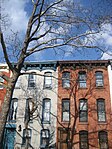The A. I. Namm & Son Department Store is a commercial structure at 450–458 Fulton Street, at the southeast corner with Hoyt Street, in the Downtown Brooklyn neighborhood of New York City, United States. It is the last remaining structure of a complex of buildings constructed for the A. I. Namm & Son Department Store chain. The current structure, built in 1924–1925 and expanded in 1928–1929, is eight stories tall and was designed by Robert D. Kohn and Charles Butler in the Art Deco style. It is a New York City designated landmark.
The A. I. Namm & Son store was founded in 1876 by the Polish immigrant Adolph I. Namm in Manhattan's Ladies Mile district. Namm moved to Brooklyn in 1885, and the store moved to the intersection of Fulton and Hoyt streets in 1890. The store expanded several times over the next three decades, covering nearly the entire city block. By the 1920s, it was one of the United States' largest cash-only department stores. The current structure replaced Namm's original building on the site when it was completed in February 1925, and it was expanded in November 1929. The buildings underwent several renovations between the 1930s and the 1950s. After Namm's merged with Frederick Loeser & Co. in the 1950s, the Namm-Loeser chain closed its former Brooklyn store. Most of the site was razed in 1957, while the remainder of the building operated as an Abraham & Straus store until 1980. Since then, the structure has been resold several times.
When the current buildings were completed, few contemporary architectural publications wrote about the structures. The facade of the current building is divided horizontally into four sections and includes decorative features such as pilasters, balconies, and pediments. As built, the first two stories were clad in bronze and stone, while the upper stories were clad in limestone. There is a curved corner at the intersection of Fulton and Hoyt streets, and the building originally had a large entrance on Fulton Street. Inside, the basement and several above-ground stories were used as sales floors, while the upper stories had inventory rooms and offices. The previous buildings on the site contained additional selling space for the A. I. Namm store.









